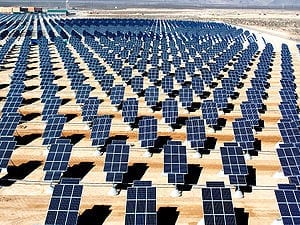
Electric power companies challenge “net metering” policies, saying nonsolar households end up with higher costs.
An energy revolution is happening atop homes in the United States, with one new rooftop solar system being installed every four minutes in 2013.
Great for the environment. Not so good for the U.S. electric companies that happen to be in solar energy hot spots.
U.S. policymakers encourage and subsidize solar installations by allowing solar households essentially to run their electric meters backwards if they generate enough energy to feed into the grid. Each month, those households pay utilities less, sometimes much less, for energy. (See related blog post: “Time to Break Free of Net-Metering; We Need a ‘FIT’ Policy for Renewable Energy to Soar.”)
These so-called “net metering” policies are adding up to a headache for electric company officials, who are watching monthly utility income shrink as more and more solar panels crown the homes in their service areas. (Take the related quiz: “What You Don’t Know About Solar Power.”)
Many solar advocates see this as a positive demonstration that renewable technology is on its way to revolutionizing the deeply entrenched fossil-fueled energy system. But utilities argue that solar households are avoiding paying their fair share for the electric grid they still rely on, and the long-term investments the companies have made in power plants and the delivery grid. Solar rooftops represent “the largest near-term threat” to the utility business model, a “disruptive challenge,” even though they still represent less than one percent of the U.S. retail electricity market, an industry study said earlier this year. (See related story: “Desert Storm: Battle Brews Over Obama Renewable Energy Plan.”)
A backlash has begun in the leading U.S. solar markets, with utilities seeking to scale back net metering or increase what they charge solar households.
In California, the number one state for solar energy, a months-long lobbying battle raged until this fall, when lawmakers crafted a compromise. Sacramento preserved net metering for now, but directed the state’s Public Utility Commission to come up with a new program by 2017 that ensures nonsolar customers don’t get stuck with an unfair burden of paying for the grid. Next door in Arizona, regulators also deferred a showdown, voting in November to allow the state’s largest utility to tack an additional fee, about $5 a month, on the bill of customers with new solar installations. It’s far less than the $50 monthly surcharge Arizona Public Service originally sought.
And in Colorado, the state Public Utility Commission is weighing a request by the state’s largest power provider, Xcel Energy, that the credits that solar households see on their utility bills for rooftop-generated energy be slashed in half. Hearings are scheduled for early February, with a decision sometime in the first half of the year. Skirmishes over the issue also have erupted in Louisiana and Idaho.
“Net metering allows consumers to build a system on their roofs that is enough to offset their electricity needs,” said Bernadette Del Chiaro executive director of the California Solar Energy Industries Association (CALSEIA), the state’s oldest and largest solar trade association. The organization’s web site calls the overhaul now being weighed by the state PUC both “the greatest opportunity and threat to the solar industry.” Net metering is “really critical for making solar make sense and work in a residential sector,” said Del Chiaro.
But utilities argue that net metering enables solar customers to benefit from a reliable electric grid without paying for its use. “It’s not about lost revenue . . . We want to make sure the grid is maintained, that it can be enhanced, and that cost shifting does not occur,” said David Owens, executive vice president of business operations at the Edison Electric Institute (EEI), a Washington, D.C.-based association that represents investor-owned utilities. (See related story: “Post-Hurricane Sandy, Need for Backup Power Hits Home.”)
Solar Boom
The net metering conflict has erupted because of one important development: Solar is now within the price range of far more customers. Since 2008, the price of the photovoltaic (PV) panels that convert sunlight to electricity has fallen by 75 percent, and solar installations have multiplied tenfold. Some homebuilders even include rooftop panels as a standard feature on new homes. Making solar even more affordable is the proliferation of solar leasing companies, which build and retain ownership of rooftop systems; customers can avoid making large upfront payments for installation, instead paying a monthly lease or power purchase fee. Two-thirds of solar installations in California in the past two years were done under lease agreements.
The third quarter of 2013 turned out to be the largest ever for residential PV installations in the United States, with the amount of additional new capacity up 35 percent over a year ago. This year is likely to be the first time in more than 15 years that the U.S. installs more solar capacity than Germany, the nation with the most installed solar capacity, according to GTM Research forecasts. That puts the U.S. third in the world in pace of solar installations, behind China and Japan.
In the United States, there were at least 302,000 “distributed” solar installations—essentially, systems on rooftops, not at power plants—installed across the United States in 2012, and the number could grow by a third in 2013, according to the Solar Electric Power Association (SEPA). More than 99.5 percent of those installations were net metered. Those solar systems add up to 3,440 megawatts of capacity, nearly as much as the largest nuclear power plant in the United States, Arizona’s Palo Verde. But it still represents a tiny fraction of U.S. electric power plant capacity, 1.2 million megawatts spread through 19,023 generating stations.
Net metering policies, currently enacted in 43 states and encouraged by U.S. law, require utility companies to credit customers for solar energy they generate in excess of their own household or business needs. When a rooftop system delivers this extra energy to the grid, the customer is compensated with a bill credit, often at the same rate per kilowatt-hour that customers pay for power from the grid.
Just how quickly those solar credits could be adding up in California became clear earlier this year when the California Public Utility Commission published a controversial report concluding that by 2020, net metering could end up costing nonsolar customers at least $370 million annually, and—by one calculation—as much as $1.1 billion. (See related story: “Mojave Mirrors: World’s Largest Solar Energy Ready to Shine.”)
Adam Browning, executive director of the nonprofit Vote Solar Initiative, scoffs at the higher figure, which includes not only energy the solar households send to the grid, but the power they keep for their own use—energy that never touches the grid and has no impact on other ratepayers. “It’s the functional equivalent of you turning off your lights and getting accused of raising everyone else’s rates,” Browning said.
The Latest on: Net metering
[google_news title=”” keyword=”Net metering” num_posts=”10″ blurb_length=”0″ show_thumb=”left”]
via Google News
The Latest on: Net metering
- Net metering consumers: PD presents buyback rate cut mechanism to prime ministeron April 27, 2024 at 7:56 pm
ISLAMABAD: The Power Division has reportedly presented a mechanism to Prime Minister Shahbaz Sharif to reduce buyback rates of net metering consumers aimed at saving other domestic consumers from the ...
- PSC staff ponder net-metering dispute that could affect solar projects across West Virginiaon April 27, 2024 at 7:31 pm
State Public Service Commission staff are puzzling over a complaint filed by the Coalfield Development Corp. that they say could affect the future of solar power across the state. Its recommendation ...
- Govt mulls slashing solar Net Metering rates by Rs10 per uniton April 25, 2024 at 7:07 pm
The government is contemplating a significant reduction in the rates paid to consumers who generate solar power through net metering, a move that may ignite criticism and concern. The potential change ...
- Cornwall Electric offering net-metering program to customerson April 25, 2024 at 9:54 am
Successful applicants who meet the requirements of Ontario’s Net Metering Regulation can generate electricity to offset their electricity consumption and send surplus electricity to the distribution ...
- Govt Planning to Drastically Reduce Solar Net Metering Buyback Rateson April 24, 2024 at 11:44 pm
The government is considering reducing buyback rates for net metering electricity, potentially lowering them from the current Rs. 21 to Rs. 11 per unit.
- Net metering power: Govt mulling bringing buyback rates down to Rs11/uniton April 24, 2024 at 8:05 pm
ISLAMABAD: The government is mulling rationalization of buyback rates of net metering electricity to Rs 11 per unit from current rates of Rs 21 per unit, well-informed sources told Business Recorder. ...
- Making Carbon Neutrality a Reality at DUon April 24, 2024 at 5:00 am
The University of Denver is taking a bold step toward reaching its goal of carbon neutrality by the year 2030. Today, the University announced a new partnership with solar power company Pivot Energy ...
- Trump's Net Worth Swells by $1 Billionon April 23, 2024 at 1:47 pm
The former president was set to receive another windfall based on the performance of his social media company on the public markets.
- New Jersey Solar Panel Incentives: Net Metering, Tax Breaks and Moreon April 18, 2024 at 1:30 pm
With state incentives, the decision to install solar panels becomes a lot easier. Here’s how you can save (and even earn) money with solar panels in New Jersey.
- GRU Authority makes controversial change to solar net metering system, holds final meetingon April 18, 2024 at 10:58 am
The GRU Authority board voted to change the utility's net metering system, a move which will result in reduced savings for customers using solar.
via Bing News









